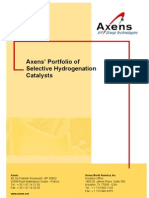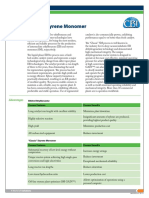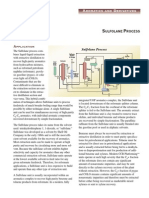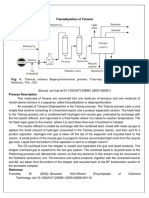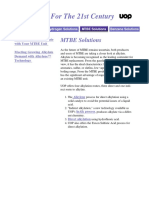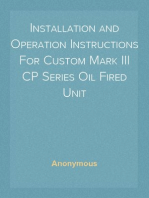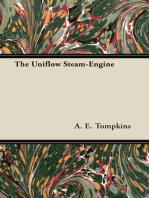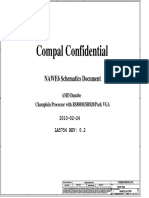Tatoraytechsheet PDF
Tatoraytechsheet PDF
Uploaded by
AnubhavAgarwalCopyright:
Available Formats
Tatoraytechsheet PDF
Tatoraytechsheet PDF
Uploaded by
AnubhavAgarwalOriginal Title
Copyright
Available Formats
Share this document
Did you find this document useful?
Is this content inappropriate?
Copyright:
Available Formats
Tatoraytechsheet PDF
Tatoraytechsheet PDF
Uploaded by
AnubhavAgarwalCopyright:
Available Formats
AROMATICS AND DERIVATIVES
TATORAYTM PROCESS
APPLICATION The Tatoray process reactions are conducted in a hydro-
The Tatoray process is used to selectively convert gen atmosphere to minimize coke formation on the cat-
toluene and C9 aromatics (A9) into benzene and xylenes. alyst. Because there is negligible ring destruction in the
In a modern aromatics complex, this process is inte- Tatoray process, there is very little hydrogen consump-
grated between the aromatics extraction and xylene tion. The methyl groups are highly stable at reaction con-
recovery sections of the plant. Extracted toluene is fed ditions and are therefore essentially conserved in the
to the Tatoray process unit rather than being blended reaction. Most of the hydrogen consumption can be
into the gasoline pool or sold for solvent applications. attributed to the cracking of the nonaromatic impurities
in the feed to the Tatoray process unit.
To maximize the production of para-xylene from the
complex, the A9 byproduct can also be fed to the UOP’s TA-5 catalyst has demonstrated high activity and
Tatoray process unit. This shifts the chemical equilib- high stability as compared to its predecessor TA-4. The
rium from benzene production to xylenes production. In stability of TA-5 is more than double, which results in
recent years, the demand for para-xylene has out- improved on-stream efficiency and a reduction in regen-
stripped the supply of mixed xylenes. The Tatoray eration frequency. Commercial performance of this cat-
process provides an ideal way to produce additional alyst has been outstanding. The catalyst is regenerated
mixed xylenes from low-value toluene and heavy aro- in-situ using a simple carbon burn procedure.
matics. Incorporating a Tatoray process unit into an
aromatics complex can more than double the yield of PROCESS DESCRIPTION
para-xylene from a given naphtha feedstock. The Tatoray process uses a very simple flow scheme
consisting of a fixed-bed reactor and a product sepa-
PROCESS CHEMISTRY ration section. The fresh feed to the Tatoray process
The two major reactions in the Tatoray process are unit is combined with hydrogen-rich recycle gas, pre-
disproportionation and transalklyation. The conversion heated by exchange with the hot reactor effluent, and
of toluene into benzene and xylenes is called toluene vaporized in a fired heater where it is raised to reaction
disproportionation (TDP). Transalklyation is the con- temperature. The hot feed vapor goes to the reactor,
version of a mixture of toluene and A9 into xylenes. The where it is sent down-flow over a fixed bed of catalyst.
Tatoray process is the only commercial technology The reactor effluent is cooled by exchange with the
that successfully combines both in a single unit. combined feed, mixed with make-up gas to replace the
This process is designed to function at a much higher small amount of hydrogen consumed in the Tatoray
level of conversion per pass than other toluene dispro- process reactor, and then sent to a product separator.
portionation processes. With a typical 50:50 feedstock Hydrogen-rich gas is taken off the top of the separator
ratio of toluene and C9 aromatics, the overall conversion and recycled back to the reactor. A small portion of
is approximately 50% per pass. This high conversion the recycle gas is purged to remove accumulated light
level minimizes the amount of unconverted material that ends from the recycle gas loop. Liquid from the bottom
must be recycled back through the BT fractionation of the separator is sent to a stripper column.
section of the complex. A smaller recycle stream mini- The C5 overhead from the stripper is cooled and sepa-
mizes the size of the benzene and toluene columns, the rated into gas and liquid products. The stripper over-
size of the Tatoray process unit, and the utility con- head gas is exported to the fuel gas system. The
sumption of all of these units. overhead liquid is recycled back to the PlatformingTM
xylene product from a Tatoray process unit contains an
Tatoray Process equilibrium distribution of xylene isomers and is very low
Feed Surge
Drum
Heater Reactor Separator
Purge
Stripper in ethyl benzene (EB). This low EB concentration makes
Gas to
Isomar Unit
Fuel Gas
the xylenes produced by the Tatoray process valuable as
Toluene from
Toluene Column
feedstock to either a ParexTM process or a para-xylene
C9 Aromatics
from A9 Column
crystallization unit.
Overhead Liquid
to Platforming Unit
Toluene from Debutanizer
Parex Unit
ECONOMICS
The investment cost and utility consumption for a typical
Recycle Gas Tatoray process unit is shown below. The basis for this
case is a unit processing 355 KMTA(7,700 BPSD) of a
process unit debutanizer column so that any benzene in feed consisting of 60 wt-% toluene and 40 wt-% A9. The
this stream may be recovered in the Sulfolane (extraction) investment cost is limited to the Tatoray process unit and
unit. The benzene and xylene products, together with the stripper column and does not include further downstream
unreacted toluene and A9, are taken from the bottom of product fractionation. The estimated inside battery limits
the stripper and recycled back to the BT fractionation (ISBL) erected cost for the unit assumes construction on a
section of the aromatics complex. U.S. Gulf Coast site in 1999.
Estimated ISBL Cost,* US MM$
PROCESS PERFORMANCE (including initial catalyst and
A Tatoray process unit is capable of processing feed- chemical inventories) 11.3
stocks ranging from 100 wt-% toluene to 100 wt-% A9. Utility Consumption
The optimal concentration of A9 in the feed is typically Electric power, kW 341
40-60 wt-%. The ability to process A9 makes more feed- High pressure steam, MT/hr 11.2
stock available for xylenes production and dramatically Cooling water, m3/h 478
shifts the selectivity of the unit away from benzene. Fuel fired, kcal/hr (millions) 10
*Includes engineering, procurement, erection of equipment on site, and the initial
An aromatics complex without a Tatoray process unit can load of TA-4 catalyst.
produce approximately 200,000 MTA of para-xylene COMMERCIAL EXPERIENCE
from 25,000 BPSD of Light Arabian naphtha (160-300°F
cut). If an A7 Tatoray process unit (toluene feed only) is As of mid-2001, UOP had licensed a total of 47 Tatoray
added to the complex, the same amount of naphtha can process units, 29 of them in the last 15 years. Feedstocks
produce 280,000 MTA of para-xylene, a 40% increase. range from 100 wt-% toluene to a mixture of 30 wt-%
When an A7/A9 Tatoray process unit is added to the com- toluene and 70 wt-% A9. Design feed rates range from 17
plex, the endpoint of the naphtha is increased from 300 to to 146 m3/hr (2,600 BPSD to 22,000 BPSD).
340°F in order to maximize the amount of A9 precursors
in the feed. The heavier naphtha will produce approxi- FOR MORE INFORMATION
mately 420,000 MTA para-xylene – an increase of 110% For more information, contact your UOP representative or
over the base complex. UOP at:
The Tatoray process produces petrochemical grade ben- Phone: 1-847-391-2000
zene and xylenes products. Benzene purity with 100% Fax: 1-847-391-2253
toluene feed easily meets the ASTM specifications for E-mail: petrochm@uop.com
Refined 545 grade benzene. With a feed of 50% toluene
and 50% C9 aromatics, the benzene product purity meets
the specifications for Refined 535 grade benzene. The
uop TM
© 2001 UOP LLC. All rights reserved. UOP LLC
This information is not to be taken as a warranty or representation for which UOP
assumes legal responsibility nor as permission or recommendation to practice any
25 East Algonquin Road
patented invention without a license. It is offered solely for your consideration. Des Plaines, IL 60017-5017
UOP 2699C-21a 1001AD1U www.uop.com
You might also like
- Npower Example BillDocument1 pageNpower Example BillHridoy33% (3)
- Lurgi MegamethanolDocument8 pagesLurgi MegamethanolAngeloNo ratings yet
- Tatory ProcessDocument4 pagesTatory ProcessSavita GuptaNo ratings yet
- Uop Par-Isom Process: Nelson A. CusherDocument6 pagesUop Par-Isom Process: Nelson A. CusherBharavi K S100% (1)
- Axens Portfolio of Selective Hydrogenation Catalysts - Imp - RectoDocument11 pagesAxens Portfolio of Selective Hydrogenation Catalysts - Imp - RectovijaymwaghNo ratings yet
- Hydrogen Production TechnologiesFrom EverandHydrogen Production TechnologiesMehmet SankirNo ratings yet
- The Iron Oxides: Structure, Properties, Reactions, Occurrences and UsesFrom EverandThe Iron Oxides: Structure, Properties, Reactions, Occurrences and UsesRating: 5 out of 5 stars5/5 (1)
- Tatoray ReacrorsDocument2 pagesTatoray ReacrorsgshdavidNo ratings yet
- 42 Aromatics ComplexDocument4 pages42 Aromatics Complexmostafamagdy100% (1)
- 55 SulfolaneDocument3 pages55 Sulfolaneprotosurge5084100% (1)
- Ethylbenzene Techsheet v4 3Document2 pagesEthylbenzene Techsheet v4 3mdtasarasNo ratings yet
- SS Simulation of Ethane RecoveryDocument5 pagesSS Simulation of Ethane RecoveryvasudhaNo ratings yet
- 06c5 File PDFDocument3 pages06c5 File PDFMakhdum Muhardiana PutraNo ratings yet
- Catalytic Reforming: Debutanizer Reactor Regeneration TowerDocument2 pagesCatalytic Reforming: Debutanizer Reactor Regeneration TowerAidonNo ratings yet
- Stireno 1Document2 pagesStireno 1jhonNo ratings yet
- Lummus - EBOne Process PDFDocument2 pagesLummus - EBOne Process PDFJungmuk Lee0% (1)
- Uop Tatoray Process: Antoine Negiz and Thomas J. StoodtDocument10 pagesUop Tatoray Process: Antoine Negiz and Thomas J. StoodtBharavi K SNo ratings yet
- Extracción de AromáticosDocument3 pagesExtracción de AromáticosjjdottaNo ratings yet
- Unit 10 Methanol To OlefinDocument19 pagesUnit 10 Methanol To Olefinsafavi91No ratings yet
- High Performance Trays For A Fractionator - in - A - AromaticsDocument5 pagesHigh Performance Trays For A Fractionator - in - A - AromaticsB rgNo ratings yet
- EthyleneDocument4 pagesEthyleneAlejandro Giraldo ZuluagaNo ratings yet
- 2020 10 15 Olefins Conversion Tech Sheet - 231117 - 162711Document2 pages2020 10 15 Olefins Conversion Tech Sheet - 231117 - 162711ediah004No ratings yet
- Transalkylation of TolueneDocument2 pagesTransalkylation of TolueneAidonNo ratings yet
- Transalkylation of Toluene PDFDocument2 pagesTransalkylation of Toluene PDFAidonNo ratings yet
- Advanced Recycle Paraffin Isomersation TechnologyDocument8 pagesAdvanced Recycle Paraffin Isomersation TechnologytungksnbNo ratings yet
- Petrochemical FeedstockDocument16 pagesPetrochemical FeedstockAstri HandayaniNo ratings yet
- 3 .s10563-007-9023-3Document5 pages3 .s10563-007-9023-3mohamed magedNo ratings yet
- Ethylbenzene SeniorDesign2rev03Document1 pageEthylbenzene SeniorDesign2rev03linh leNo ratings yet
- Lecture 6Document41 pagesLecture 6Pragati GhumadeNo ratings yet
- Metal Supported Zeolite For Heavy Aromatics Transalkylation ProcessDocument10 pagesMetal Supported Zeolite For Heavy Aromatics Transalkylation ProcessArash AbbasiNo ratings yet
- Distinctive Technology For Methano Plants PDFDocument6 pagesDistinctive Technology For Methano Plants PDFMaribel ParragaNo ratings yet
- PX PtaDocument39 pagesPX PtaAshok Sharma100% (1)
- Investigation of Kinetics of Hydroisomerization of C /C and C /C Alkanes and Their Binary MixturesDocument4 pagesInvestigation of Kinetics of Hydroisomerization of C /C and C /C Alkanes and Their Binary MixturesOmar SaeedNo ratings yet
- Benzene XyleneChemicals 30052012Document50 pagesBenzene XyleneChemicals 30052012Chakravarthy Bharath100% (1)
- 11bDocument8 pages11bDaniela MeloNo ratings yet
- Compabloc Cuts Steam Consumption in Aromatics Plant - Case Story - enDocument2 pagesCompabloc Cuts Steam Consumption in Aromatics Plant - Case Story - enswaggeroni yololoNo ratings yet
- Lec 20Document3 pagesLec 20Kanhaiya KumarNo ratings yet
- Development of A Kinetic Model For Catalytic ReformingDocument9 pagesDevelopment of A Kinetic Model For Catalytic ReformingFernandpNo ratings yet
- SMART Styrene 12 PDFDocument2 pagesSMART Styrene 12 PDFAntonela PortaNo ratings yet
- RefinacionDocument4 pagesRefinacionAngelSosa100% (1)
- Alkylation, Isomerisation and PolymerisationDocument27 pagesAlkylation, Isomerisation and PolymerisationSudarshan GopalNo ratings yet
- Benzene Toluene Fractionation Unit: BackgroundDocument2 pagesBenzene Toluene Fractionation Unit: BackgroundHemanth Peddavenkatappa GariNo ratings yet
- Phenol TechSheet 2014 FINALDocument2 pagesPhenol TechSheet 2014 FINALahmedNo ratings yet
- Cumene Mass & Energy Balance PDFDocument33 pagesCumene Mass & Energy Balance PDFMeet Khunt100% (1)
- Nextame and NextaeeDocument2 pagesNextame and Nextaeesaleh4060No ratings yet
- Extractive DistillationDocument15 pagesExtractive DistillationChisom ChubaNo ratings yet
- Alky Lene ProcessDocument3 pagesAlky Lene ProcessChristianGuerreroNo ratings yet
- Axen ExxonDocument8 pagesAxen ExxonAkshata DalviNo ratings yet
- Isomerization Process, Reactions, Effects of Process Variables. IsomerizationDocument6 pagesIsomerization Process, Reactions, Effects of Process Variables. IsomerizationAlaa El-sherbinNo ratings yet
- Olefix UOP PDFDocument2 pagesOlefix UOP PDFEmadNo ratings yet
- Efficient and Cost-Effective Amine Purification ProcessDocument1 pageEfficient and Cost-Effective Amine Purification Processandrey.glinskyNo ratings yet
- Fenol UOP PDFDocument2 pagesFenol UOP PDFJohn Dalkia100% (1)
- Disproportionation of Toluene : by Takao Iwamura, Seiya Olam and Masaki SatoDocument7 pagesDisproportionation of Toluene : by Takao Iwamura, Seiya Olam and Masaki SatoWilliam QuintanillaNo ratings yet
- Industrial Catalytic Processes-Phenol Production: Robert J. SchmidtDocument15 pagesIndustrial Catalytic Processes-Phenol Production: Robert J. SchmidtUzair WahidNo ratings yet
- 231-02 A Coremaking Revolutionco2Document5 pages231-02 A Coremaking Revolutionco2nayanNo ratings yet
- Installation and Operation Instructions For Custom Mark III CP Series Oil Fired UnitFrom EverandInstallation and Operation Instructions For Custom Mark III CP Series Oil Fired UnitNo ratings yet
- Gas-Engines and Producer-Gas Plants A Practice Treatise Setting Forth the Principles of Gas-Engines and Producer Design, the Selection and Installation of an Engine, Conditions of Perfect Operation, Producer-Gas Engines and Their Possibilities, the Care of Gas-Engines and Producer-Gas Plants, with a Chapter on Volatile Hydrocarbon and Oil EnginesFrom EverandGas-Engines and Producer-Gas Plants A Practice Treatise Setting Forth the Principles of Gas-Engines and Producer Design, the Selection and Installation of an Engine, Conditions of Perfect Operation, Producer-Gas Engines and Their Possibilities, the Care of Gas-Engines and Producer-Gas Plants, with a Chapter on Volatile Hydrocarbon and Oil EnginesNo ratings yet
- Multiphase Reactor Engineering for Clean and Low-Carbon Energy ApplicationsFrom EverandMultiphase Reactor Engineering for Clean and Low-Carbon Energy ApplicationsYi ChengNo ratings yet
- Wire & CableDocument156 pagesWire & CableYiğit Ilgaz0% (1)
- Mayan Merkaba Flowing 17 Chakras Meditation!!!: Your 5th Dimension!Document3 pagesMayan Merkaba Flowing 17 Chakras Meditation!!!: Your 5th Dimension!api-3732890No ratings yet
- ANGULAR JS Full DataDocument10 pagesANGULAR JS Full Datacherryai984835No ratings yet
- PT Ro 04 11083Document183 pagesPT Ro 04 11083jayendrapatilNo ratings yet
- Thin Layer ChromatographyDocument16 pagesThin Layer ChromatographyAmrutha KNo ratings yet
- Piping CalculationsDocument9 pagesPiping CalculationsSuper 7No ratings yet
- 12go - Asia Company PresentationDocument16 pages12go - Asia Company Presentation12goasiaNo ratings yet
- 163 - Motor Winding Single PhaseDocument12 pages163 - Motor Winding Single PhaseMSM7865No ratings yet
- Paper - Fatigue Lifetime of Welded Joints Under Random Loading - Colombini P., Dolinski K. - 2001Document11 pagesPaper - Fatigue Lifetime of Welded Joints Under Random Loading - Colombini P., Dolinski K. - 2001Claudio RodriguesNo ratings yet
- Vortex InstructionsDocument8 pagesVortex InstructionsRenee CamilleNo ratings yet
- Manual Transicion j7 A j1000Document19 pagesManual Transicion j7 A j1000fleabassistNo ratings yet
- Performance Improvement Doosan Power ServiceDocument104 pagesPerformance Improvement Doosan Power ServiceJanelle D. Puti-anNo ratings yet
- G.I. Gurdjieff & The Hidden History of The SufisDocument8 pagesG.I. Gurdjieff & The Hidden History of The SufiseereyesNo ratings yet
- Catalog Full Line English WireAndCable PDFDocument16 pagesCatalog Full Line English WireAndCable PDFEngr Abdus Saboor AhmadNo ratings yet
- Applications of Synchrophasors Technology in Smart GridDocument13 pagesApplications of Synchrophasors Technology in Smart Gridmohd zuhaibNo ratings yet
- (Oxford Handbooks) Andrew C. Isenberg - The Oxford Handbook of Environmental History-Oxford University Press (2014)Document801 pages(Oxford Handbooks) Andrew C. Isenberg - The Oxford Handbook of Environmental History-Oxford University Press (2014)Trovador Morrison100% (1)
- Stub Series Terminated Logic For 2.5 Volts (SSTL - 2)Document21 pagesStub Series Terminated Logic For 2.5 Volts (SSTL - 2)elberusNo ratings yet
- Bezaprint Orange RG - MSDSDocument9 pagesBezaprint Orange RG - MSDSMahdi100% (1)
- Santarpaniya Adhyaya - Charak SamhitaDocument216 pagesSantarpaniya Adhyaya - Charak SamhitaDavidd GuettaNo ratings yet
- Pain Management For NursesDocument42 pagesPain Management For Nursesblacknurse100% (1)
- Quest Book Cbse 9 MathsDocument29 pagesQuest Book Cbse 9 MathsRekha SharmaNo ratings yet
- Prepare Vegetable DishesDocument11 pagesPrepare Vegetable DishesFerdilyne S. PalbusaNo ratings yet
- Sanuzella D ENGLDocument25 pagesSanuzella D ENGLSteluta BoroghinaNo ratings yet
- Compal Confidential: NAWE6 Schematics DocumentDocument48 pagesCompal Confidential: NAWE6 Schematics DocumentUser000No ratings yet
- FT12 150 BatteryDocument2 pagesFT12 150 BatteryBarkah YanuarNo ratings yet
- Kru PS: Crystal Arome Model #398 Crystal Arome Time Model #458Document12 pagesKru PS: Crystal Arome Model #398 Crystal Arome Time Model #458JOSEACOSTANo ratings yet
- Cristal 121 - FinalDocument1 pageCristal 121 - FinalSajukurian7No ratings yet
- Parker TC-SeriesDocument18 pagesParker TC-SeriesSam MarmorNo ratings yet
- On BHEL and Its Organisation StructureDocument17 pagesOn BHEL and Its Organisation StructureAnkit Mehta0% (1)




